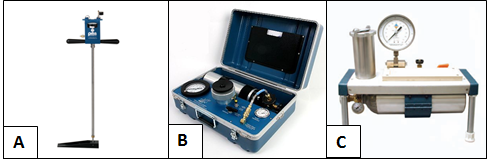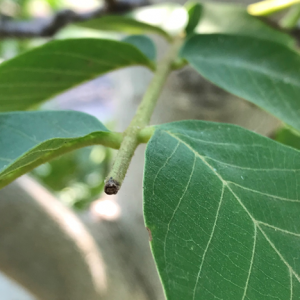Allan Fulton, UCCE Irrigation and Water Resources Advisor, Tehama, Shasta, Glenn & Colusa counties; Luke Milliron, UCCE Orchards Advisor, Butte, Tehama & Glenn counties; and Richard Buchner, UCCE Farm Advisor Emeritus, Tehama county.
Pressure Chamber Selection
Two companies are currently the main sources of pressure chambers in California. They both produce durable and portable pressure chambers for measuring stem water potential (SWP). Their chambers have the same basic components and operate on the same concept. Cost may range from about $1,500 to about $7,000, depending on the style and design. The choice of a pressure chamber depends largely on preference.
Example A (fig. 1) is a pump-up style by PMS Instruments. It is a manually operated ‘bike pump’ style chamber. Example B is a suitcase-style pressure chamber. It has a cylindrical chamber that uses nitrogen gas for pressure. Both PMS Instruments and Soil Moisture Equipment Corp. offer this style of chamber. Example C is a console- or bench-style pressure chamber by Soil Moisture Equipment Corp. that also uses nitrogen gas.

Figure 1. Three examples of commercially available pressure chambers. Photos: Courtesy of Plant Moisture Stress (PMS) Instrument Company, Albany, OR and Soilmoisture Equipment Corp., Santa Barbara, CA.
Making Stem Water Potential Measurements
Time of day
Stem water potential (SWP) is best measured at midday from 1:00 to 3:00 p.m. (or 12:00 to 4:00 p.m. if necessary). The idea is to make measurements when the tree is experiencing relatively constant and maximum water demand. From a practical standpoint, irrigation managers are interested in the highest stress that trees experience, which is also at midday. Thus, the guidelines for interpreting SWP measurements have been made by using midday measurements.
Sunny, partly cloudy, overcast or smoky days
Bright, sunny afternoon weather is preferred, but it is not always possible to wait for ideal sunny conditions. Sometimes, in the case of regional wild fires, smoky days can persist many days during the growing season. Sun obscured conditions reduce tree water demand. Measurements taken under overcast or smoky conditions indicate the actual tree stress but are likely to change when sunny conditions resume. This concern is best handled by comparing field measurements of SWP to estimates of baseline SWP for fully irrigated conditions to calculate “bars below baseline”. This will be discussed further in a future article.
Time of season
SWP measurements should begin during the spring and continue through the summer and fall. Utilizing season-long SWP monitoring offers several benefits. This approach helps indicate when to apply the first irrigation, shows how orchard water status responds to irrigation decisions, how irrigation scheduling might be improved, and how water status shifts with seasonal weather changes.
Time between irrigations
Given the constraints of time and resources, measuring SWP just before irrigating provides the most information. It will provide insight into whether the interval between irrigations needs to be adjusted. If time allows, monitoring SWP one or two days after irrigation will indicate how well the tree water status recovered after irrigation and give insight into whether the duration of irrigation is on track. Due to the high frequency, it is not necessary or feasible to measure SWP before and after every drip or microsprinkler irrigation.
How many measurements to make in an orchard
It is necessary to balance having enough trees to reliably represent the orchard and being able to cover the desired total acreage in a timely and efficient manner. A sampling strategy that can be completed in about 30 to 60 minutes per orchard is ideal. A sample size ranging from 5 to 10 trees per orchard is optimal for achieving representative measurements and covering acreage efficiently. However, the number of trees to monitor in an orchard depends on soil variability and irrigation uniformity. Fewer trees are needed if the orchard is growing on one predominant soil type with uniform irrigation. More trees are needed if there is more than one soil type and non-uniform irrigation. Trading fewer measurements for more frequent measurements is a worthy exchange. A couple measurements can have tremendous value, compared to no measurements at all!
Selecting trees for measurement
Trees selected for SWP monitoring should be representative of the orchard. Good measurement trees are the same variety/rootstock and similar in age, degree of pruning, and canopy size. Measurement trees should be healthy and irrigated in the same manner as the rest of the orchard. The trees selected for SWP measurement should be at least 100 feet inside the orchard and have other healthy trees growing around them (no sick or missing trees). The same trees should be used to measure SWP each time to reduce variation from one day to the next so sample trees should be marked with flagging, spray paint, or GPS waypoints.
When sampling small trees during the first year, excessive leaf removal may be an issue. Defoliation is generally not a concern after the first year of development. If defoliation is a concern, rotate between several uniform trees of the same variety in close proximity, therefore allowing time for new leaf growth suitable for measurement. In walnut, the compound leaves allow you to manage defoliation by repeatedly sampling from the same compound leaf (given several days between measurement). At first you sample the terminal leaflet, and subsequently you bag and remove leaflet pairs (fig. 2).
How many leaves per tree
To ensure the reading is not compromised by operator error or poor leaf selection, it is important to make two measurements per tree, or a single leaf from two adjacent trees. Compare the readings; if they are more than 0.5 to 1.0 bar apart, another leaf should be measured and the average of the closest leaves recorded. If the difference between the two leaves is great, bag another leaf and re-measure. Take the average of the closest measurements.

Figure 2. Compound walnut leaves can be sampled repeatedly to reduce defoliation. Several days after sampling the terminal leaflet, sample the closest pair of leaflets (nearest the cut).
Six other frequently asked questions during setup
Q1. Where can foil bags for covering the leaves be purchased?
Foil-laminate bags are usually provided by the pressure chamber manufacturer at the time of purchase. You can also buy additional foil bags through the manufacturer.
Q2. How long do the foil bags last?
The foil-laminate bags are used to briefly cover the sample leaves while measuring SWP. They can be used repeatedly. They are very durable, and in our experience last several growing seasons.
Q3. When can the bags be put on the sample leaves?
Based upon field research, we recommend a minimum leaf bagging duration of 10 minutes before actually taking the pressure chamber measurement. This assures the bag inside the leaf has enough time to equilibrate with the tree’s larger branches and main water conducting system. However, bagging can take place during the cooler morning, or even the previous day.
Q4. Where to purchase compressed gas, and how long will a tank last?
Nitrogen is the most commonly used compressed gas for measuring SWP. It can usually be purchased from local retailers that specialize in liquid and compressed gas. Portable tanks, most commonly 20 or 22 cubic feet in volume, are used to supply the gas. These tanks are usually rated for a maximum of 3000 psi, but generally not filled past 2500 psi.
The number of SWP measurements that can be taken with a full tank will depend on crop species and the degree of crop water stress. A tank of nitrogen will last longer when used in walnuts, than in almonds or prunes, and it will last longer in the spring than summer. An efficient pressure chamber operator should be able to complete at least 50 to 60 measurements from these small portable tanks when they register at least 2000 lbs psi of compressed gas.
Q5. Is it possible to refill the small portable tanks yourself?
Absolutely, if you plan on taking a lot of SWP measurements, having one or two large (150 cubic foot) nurse tanks is your most convenient and affordable option to make sure you are prepared for each afternoon of pressure chamber work. Because the capacity to refill the smaller portable tank declines with the declining volume of gas in the larger source tank, it is advantageous to have a second (higher pressure) nurse tank used for topping-off.
In our experience, we have been able to complete at least 400 measurements in a combination of walnut, almond, and prune orchards using one, 150 cubic foot source tank of compressed nitrogen to refill the smaller portable tanks.
Refilling does require some specialized accessories such as gauges, pressure release valves, transfer hoses, and quick couple hook-up assemblies, so that refilling can be done quickly and safely. Techniques for refilling the portable tanks may also vary with pressure chamber make and model. We recommend that you visit the following links for video tutorials on how to refill portable pressure chamber tanks:
Portable nitrogen tanks
Pressure chambers with internal tanks
Q6. Is it possible to use other types of compressed gas instead of nitrogen?
There are at least two aspects to consider: 1) mechanistic; and 2) plant physiological. From a mechanistic perspective, according to one pressure chamber retailer, valve connections are the same for nitrogen, argon, and helium, but not for carbon dioxide. So, from a manufacturing and retailer perspective, it’s simpler to just use nitrogen, although argon or helium might work. Using carbon dioxide would require retrofitting your pressure chamber.
From a plant physiological point of view, we know each of these compressed gases have unique properties, but we don’t know with certainty how they might affect the leaf inside the pressurized chamber. Based upon anecdotal evidence, and not controlled studies, it appears that nitrogen, air (using the pump-up model), and carbon dioxide can all be used to measure SWP and not affect the accuracy of the measurements and irrigation decisions. We have no experience with argon and helium. This aspect of the question could benefit from more applied research.
Note: This is the third article in a series on stem water potential. Access previously posted articles here. This series is an an abbreviated discussion based upon peer-reviewed UC ANR Publication 8503, Using the Pressure Chamber for Irrigation Management in Walnut, Almond, and Prune (2014).


Leave a Reply